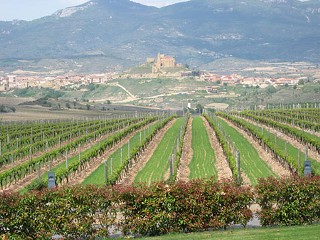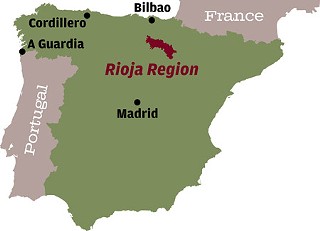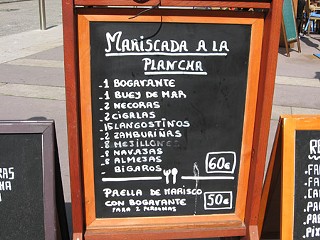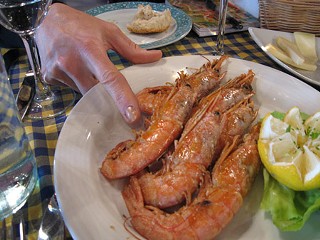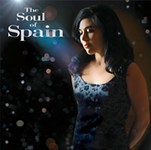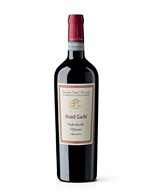Will Travel for Food and Wine
Madrid, La Rioja, the Basque Country, Asturias, and Galicia
By Wes Marshall, Fri., June 26, 2009
Looking for a trip with spectacular wine, food equal to any in the world, myriad museums, sophisticated cities, and a dazzling countryside? Let me recommend the northwestern part of Spain as a perfect 10-day to two-week trip. I was over there for a week of touring the wineries and vineyards of Rioja, followed by a driving tour of Spain that covered about 1,500 miles (2,500 kilometers). Only one day required more than four hours in the car, so most days we enjoyed leisurely drives through vineyards, valleys, and coastland so green we could have sworn it was Ireland.
Along with about 40% of the Spanish population, we drank mostly Rioja wines. For food, well, it was asparagus season. The Spanish love their asparagus white and huge, especially the famous espárrago de Navarra. For these asparagus, the circumference of a man's thumb is considered small! We saw them everywhere. The northern and western coasts of Spain were the richest shellfish areas we've ever experienced, with dozens of different types of crabs as well as a few different types of lobsters; clams; oysters and shrimp; delicious, delicate whitefish; and huge squid. The king of fish all over Spain is the salted cod called bacalao – one of the world's most delicate and sweet-fleshed fish.
Spain is about 70% the size of Texas yet has as many different microclimates and weather conditions as the United States. Much of the area we covered – at least the portion more than 50 miles away from the Bay of Biscay and the Atlantic Ocean – looked very much like the Texas Hill Country. Hills, valleys, and rivers dominated, with land that alternated between harsh limestone (perfect for Rioja's grapes) and fertile farmland. The weather was a warmish low-80s during the day and down to around 60 degrees at night, even though the area we traveled is at the same latitude as Toronto and New York City. Closer to the bay and the ocean, the weather was much cooler and as damp as the Oregon coast.
Love Those Rioja Wines
Rioja wines come in three colors: red, white, and pink. The Denominación de Origen Calificada Rioja is the governing body for Rioja wines, and it keeps strict control over which types of grapes can be used, where they can be grown, how the wines are made and matured, and finally, whether or not they taste good enough to be released with the Rioja label on them. It even helpfully rates each vintage as good (B), very good (MB), or excellent (E). With all the effort required on the part of the growers and winemakers, it's amazing that Rioja wines come to the U.S. as inexpensively as they do.
Rioja's red wines are made mainly from Tempranillo, though Garnacha (also known as Grenache), Mazuelo, and Graciano are also used. Whites are mainly Viura, though Malvasia and Garnacha Blanca are also used. The Denominación de Origen Calificada Rioja is experimenting with allowing Verdejo, Sauvignon Blanc, and Chardonnay on the list of whites, but don't expect to see any for the next few years.
There are four types of Rioja. Joven wines are young and fresh, one to two years old, and almost never make it to our country. Crianzas are the huge group of wines that see the most consumption worldwide. They must spend one year in barrels (six months for white wines) and at least a few months in bottles and cannot be sold until they're at least three years old. Reserva wines can only come from vintages ranked E. They must age for at least three years (two years for whites), at least one of which has to be in barrels (six months for whites). Gran Reservas are the top of the line in Rioja, also only made from E-grade vintages. The red versions age at least five years, the whites four.
The style of wine in Rioja has changed over the last decade as consumers' tastes have moved dramatically toward big, fruity wines. Red Riojas were acidic wines that required years to soften. They still won't taste like a Sonoma Zinfandel, but now they are much fruitier than before, with strawberry and cherry aromas. As they move up the scale from Joven to Gran Reserva, the reds take on nongrape aromas such as leather, cigar box, cinnamon, chocolate, and licorice. Most Spanish red wines are ready to drink at release.
White Riojas are magnificent with shellfish, especially crab and shrimp. Very occasionally, we'll get white Reservas or even Gran Reservas here in the States. These wines would appeal to folks who love vanilla, peach, and pear aromas in their white wines. In fact, the best pairing we had with these wines was cold shrimp with a light pear salsa using the famous Pera de Rincón de Soto pears.
The Rioja Rosés should appeal to all Texans. Bone-dry and chock-full of strawberry and pepper aromas, these wines were most commonly seen in the hands of older folks strolling through the tapas bar areas looking for an evening snack.
How to Enjoy Tapas
We were lucky enough to have the guidance of local foodie Rebeca Gómez Aiello as we traveled through the crowded streets of Logroño, one of the busiest commercial towns in La Rioja. It was her hometown, and she knew where to go, what to buy, where to find a place to sit, and how to deal with the occasional panhandler ("¡Váyase a la mierda!"). Her secret was always to look for crowds of people talking amongst one another, indicating a place popular with locals, with good food at fair prices. She taught us that each tapas bar has a specialty – order a small beer ("corto") and the house specialty, and when you finish those, move along to the next spot.
Though we ate brilliant tapas all over Spain, the most memorable place of all was in Madrid – Taberna Tempranillo. Its specialty was garbanzos con chipirones, a gorgeous stew of baby garbanzo beans and tiny squid. For nine euros, one bowl was just the right size for two people. The prize for hedonism went to one of the Taberna's most frequently ordered dishes, potatoes and foie (14 euros), a large bed of crispy fries topped with three fried eggs and a piece of foie gras the size of a deck of cards. The recommended way to eat this delicious creation is to cut across several times with a knife and fork, turn the plate a quarter-turn, and repeat, distributing the eggs and foie onto every piece of potato. Wow!
Our prize for the best towns for tapas is a tie between Logroño and Madrid. Logroño wins for having a compact area (La Laurel), for having virtually no tourists, and for being surrounded by Spain's greatest wines in Rioja. Madrid wins for shopping (every bit as sophisticated as Rome or Paris), museums, and its abundance of sunny squares where you can eat, drink, and watch street performers plying their trades.
This might be a good place to note that Spaniards and Americans have very different ideas about eating times. The communal squares start to fill up around 5pm, and tapas bars (ubiquitous in every town) start to fill up around 9pm with cute old ladies drinking Rosés and are really full by 9:30pm. The tapas bars empty around 2am. In the cities, that's just in time for the clubs to open and rock until past dawn. Maybe Spaniards eat all those oysters to keep strong!
The People
Everywhere we went, large cities or tiny towns, we were treated wonderfully. The Spanish people largely just leave tourists alone but respond with patience and good cheer when asked for help. The Spanish spoken there is as different from Mexican Spanish as the English spoken in Texas is from English in Australia. Most people at places catering to tourists will speak some English, though everyone responded nicely when I mangled their language trying to speak Spanish.
We found Spanish customs very appealing, especially the widespread value placed on the arts. The people we encountered were far more social than Americans, and despite the tanking economy, Spanish people all seemed so happy. Sitting on a square, having a beer, laughter is likely to drown out all other sounds. Everyone is hugging and kissing. The street musicians are as likely to be a string quartet playing Vivaldi as itinerant singer-songwriters. The opera houses thrive. And this is a small point but a compelling one: Museums in Spain frequently open for free (the Prado is free for the last hour every day) so that folks who can't afford the entry price can still experience fine art.
This confluence of art appreciation, congeniality, and love of great food and wine makes Spain a treasure, one that seems to be resisting the homogenization faced by other European Union nations. Well-made wine, exquisite food, and great art – Spain should be on anyone's short list of travel destinations.
Recommended Restaurants
Marqués de Riscal Restaurant
Calle Torrea 1. Elciego (Álava)
www.marquesderiscal.com
Francis Paniego, of Michelin-starred restaurant Echaurren, oversees the food. Very small, impeccable service, and superb, creative food, with both modern and traditional foods available. Expensive.
Taberna Tempranillo
Calle de la Cava Baja 38, Madrid
The best tapas on Madrid's best tapas street.
Bazaar
Calle Libertad 21, Madrid
Where young professionals meet for great food at affordable prices.
Sidrería el Remo Restaurante
Calle Fuente de Abajo 9, Cudillero (Asturias)
www.sidreriaelremo.com
One hundred feet from the ocean and the seafood tastes it. Heaven for folks who love bone-dry hard cider.
Restaurante Bitadorna
Rúa do Porto 30, A Guarda
www.bitadorna.com
Directly in front of the bay. Most of the seafood is alive when you buy it.
Restaurante Guggenheim Bilbao
Avda. Abandoibarra 2,
Bilbao (Vizcaya)
www.restauranteguggenheim.com
One of the best restaurants in Spain. Very small, reservations necessary. Expensive.
Recommended Hotels
Hotel Monumento Convento de San Benito
Plaza de San Benito, A Guarda/Pontevedra (Galicia)
www.hotelsanbenito.es
An old convent right on the water and adjacent to some of the best seafood restaurants in Galicia.
Hotel Marqués de Riscal
Calle Torrea 1, Elciego (Álava)
www.marquesderiscal.com
Extremely expensive but worth a splurge. A work of art by
Frank Gehry.
Room Mate Laura Hotel
Travesía de Trujillos 3, Madrid
www.room-matehotels.com
Small boutique, well-priced with excellent service.
La Casona de Pio
Calle Riofrío 3,
Cudillero (Asturias)
www.lacasonadepio.com
In a small coastal town. Intimate and comfortable.
Shellfish
The coastline all the way from the French border to the Portuguese border is a paradise for shellfish lovers. As I mentioned, the selection was huge, and most coastal towns have restaurants that serve heaping plates of whatever shellfish is fresh that day. For anywhere between 50 and 75 euros, they serve enough food for two defensive linemen or four normal people. Here is the translation for the menu above: one lobster, one huge crab, two of another type of crab, two almost lobster-sized crayfish, 15 large shrimp (pictured), two large scallops with roe on the half shell, eight mussels, eight razor clams, eight clams, all on a bed of sea snails. Sitting on the ocean shore with a bottle of white Rioja Reserva and this plate of shellfish is about as good as eating gets.





